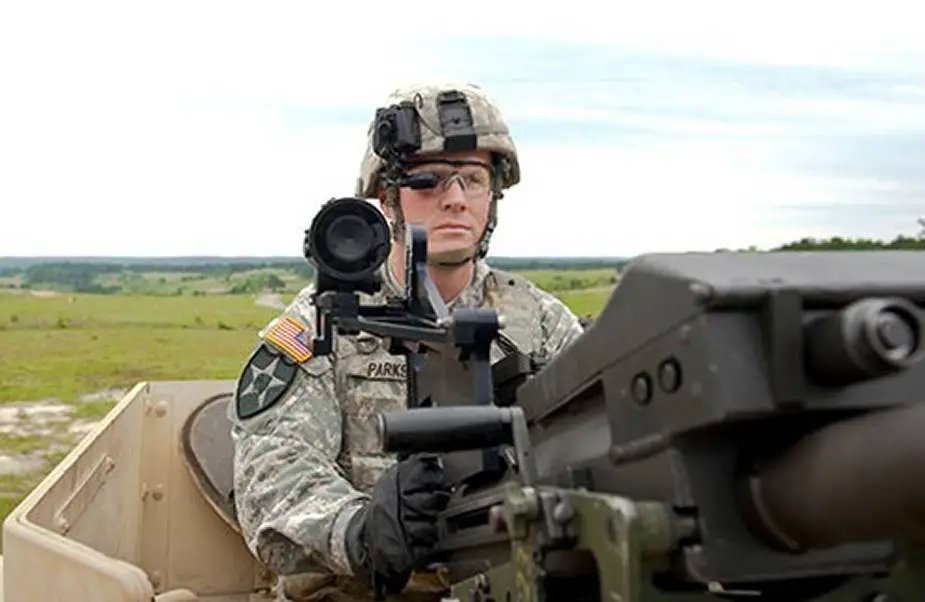US Army sets sights on advanced manufacturing of eyepieces
Augmented reality is no longer only part of sci-fi movies and video games. It has moved to the forefront as a key technology to train Soldiers for future battles. Augmented reality devices provide information before, during and after operations, enabling Soldiers to train throughout each phase of a mission. Invaluable feedback from training helps Soldiers prepare for real-world situations. Argie Sarantinos, DEVCOM Public Affairs, reports.
Follow Army Recognition on Google News at this link

The new prism eyepiece can be used with the U.S. Army's family of weapon system sights. (Picture source: U.S. Army)
A key part of an augmented reality device is a heads-up display that enhances real-world scenes during training. The heads-up display, which is integrated with a Soldier’s helmet, includes advanced eyewear that can provide the positions of allied and enemy forces superimposed over a scene. The displays can also be integrated with gun mounted targeting capabilities that allow Soldiers to see around corners during training and actual combat. Current display technology has several challenges including: eyepieces with a limited field of view; conventional optics that are too heavy; and image quality that is limited by the performance of current materials.
The Army’s ManTech program led a project to mature manufacturing of low cost augmented reality eyepieces that can be used on air and ground platforms and for dismounted Soldiers and training and simulation applications. The prism eyepieces provide high resolution imagery across a wide field of view for improved situational awareness. The ManTech team worked with four potential suppliers to address manufacturing gaps in developing prism-based augmented reality eyepieces.
“This effort was an ideal project for the ManTech team. We started with an optical technology that met most of the Army’s requirements, but unit production costs were too high. By focusing on core manufacturing processes, which enabled a family of related products, we found several fabricators who could meet our desired unit cost,” said John Hall, project manager, DEVCOM C5ISR Night Vision and Electronic Sensors Directorate.
The ManTech team leveraged Other Transaction Authority, or OTA, contracts, which enabled government engineers to open communications with fabricator and machine shop organizations and quickly award contracts. The OTAs also provided direct access to several optical fabrication organizations that normally do not directly work with Department of Defense agencies. The Army Futures Command is leveraging OTAs to expedite the technology development process. The Army’s ManTech program is managed by the Assistant Secretary of the Army (Acquisition, Logistics, and Technology) within the office of the Deputy Assistant Secretary of the Army for Research and Technology, and project tasks are executed by DEVCOM, which is a major subordinate command of AFC.
One of the key management tools for driving down costs was a step-by-step list with material and labor costs and yield percentage. This living document made it very easy to spot problem areas, and it provided objective evidence to support improved unit cost pricing.
The unit cost of the prism eyepieces was reduced by using optical quality plastic materials, which is more cost effective than alternate materials. Costs were further reduced by examining the step-by-step process – evaluating each step for cost and yield – and then conducting experiments to find alternate ways to conduct the steps. In some cases, simply rearranging the step sequence led to improvements in unit cost.
“There is fierce competition from competing waveguide technologies, but so far the prism solutions have an advantage with brightness and field of view. The ManTech project reduced the cost of high-resolution prism eyepieces by at least ten times by increasing the supplier base and allowing each fabricator to iterate several cycles of production process optimization,” Hall said.
The C5ISR Night Vision and Electronic Sensors Directorate, which develops technologies including the Soldier’s heads up display, created a government-owned design drawing package that was distributed to the companies. The ManTech team also solicited two companies that produce and sell head-mounted display products to assist in fabricating the prism eyepieces.
As a result of this effort, several new free-form prism eyepiece products have recently appeared on the market and are now found in various military training simulators, remote vehicle pilot stations, and individual Soldier display systems. Program Executive Office Soldier has also conducted user operational testing on the prism eyepieces.
“I was very impressed by the image and the free form prism technology. I think the technology offers a great opportunity for Soldier borne applications where low power, light weight and high image quality [brightness and resolution] are critical,” said Wayde Thomka, PEO Soldier project manager.


























